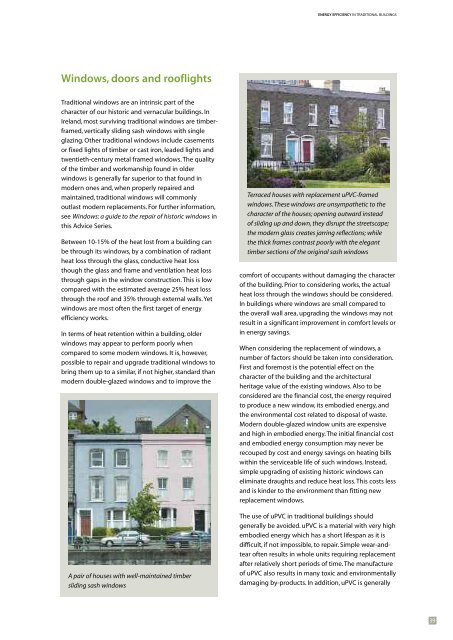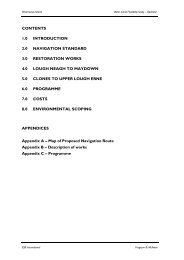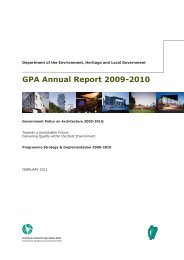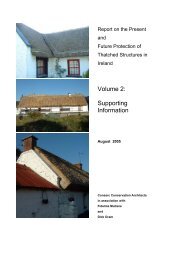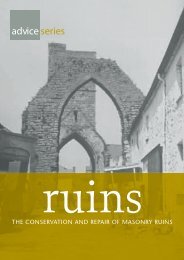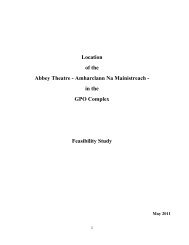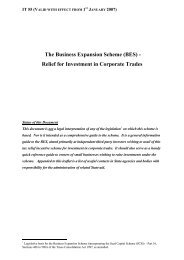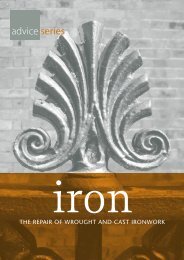Energy Efficiency in Traditional Buildings - Dublin City Council
Energy Efficiency in Traditional Buildings - Dublin City Council
Energy Efficiency in Traditional Buildings - Dublin City Council
You also want an ePaper? Increase the reach of your titles
YUMPU automatically turns print PDFs into web optimized ePapers that Google loves.
ENERGY EFFICIENCY IN TRADITIONAL BUILDINGS<br />
W<strong>in</strong>dows, doors and rooflights<br />
<strong>Traditional</strong> w<strong>in</strong>dows are an <strong>in</strong>tr<strong>in</strong>sic part of the<br />
character of our historic and vernacular build<strong>in</strong>gs. In<br />
Ireland, most surviv<strong>in</strong>g traditional w<strong>in</strong>dows are timberframed,<br />
vertically slid<strong>in</strong>g sash w<strong>in</strong>dows with s<strong>in</strong>gle<br />
glaz<strong>in</strong>g. Other traditional w<strong>in</strong>dows <strong>in</strong>clude casements<br />
or fixed lights of timber or cast iron, leaded lights and<br />
twentieth-century metal framed w<strong>in</strong>dows. The quality<br />
of the timber and workmanship found <strong>in</strong> older<br />
w<strong>in</strong>dows is generally far superior to that found <strong>in</strong><br />
modern ones and, when properly repaired and<br />
ma<strong>in</strong>ta<strong>in</strong>ed, traditional w<strong>in</strong>dows will commonly<br />
outlast modern replacements. For further <strong>in</strong>formation,<br />
see W<strong>in</strong>dows: a guide to the repair of historic w<strong>in</strong>dows <strong>in</strong><br />
this Advice Series.<br />
Between 10-15% of the heat lost from a build<strong>in</strong>g can<br />
be through its w<strong>in</strong>dows, by a comb<strong>in</strong>ation of radiant<br />
heat loss through the glass, conductive heat loss<br />
though the glass and frame and ventilation heat loss<br />
through gaps <strong>in</strong> the w<strong>in</strong>dow construction. This is low<br />
compared with the estimated average 25% heat loss<br />
through the roof and 35% through external walls. Yet<br />
w<strong>in</strong>dows are most often the first target of energy<br />
efficiency works.<br />
In terms of heat retention with<strong>in</strong> a build<strong>in</strong>g, older<br />
w<strong>in</strong>dows may appear to perform poorly when<br />
compared to some modern w<strong>in</strong>dows. It is, however,<br />
possible to repair and upgrade traditional w<strong>in</strong>dows to<br />
br<strong>in</strong>g them up to a similar, if not higher, standard than<br />
modern double-glazed w<strong>in</strong>dows and to improve the<br />
A pair of houses with well-ma<strong>in</strong>ta<strong>in</strong>ed timber<br />
slid<strong>in</strong>g sash w<strong>in</strong>dows<br />
Terraced houses with replacement uPVC-framed<br />
w<strong>in</strong>dows. These w<strong>in</strong>dows are unsympathetic to the<br />
character of the houses; open<strong>in</strong>g outward <strong>in</strong>stead<br />
of slid<strong>in</strong>g up and down, they disrupt the streetscape;<br />
the modern glass creates jarr<strong>in</strong>g reflections; while<br />
the thick frames contrast poorly with the elegant<br />
timber sections of the orig<strong>in</strong>al sash w<strong>in</strong>dows<br />
comfort of occupants without damag<strong>in</strong>g the character<br />
of the build<strong>in</strong>g. Prior to consider<strong>in</strong>g works, the actual<br />
heat loss through the w<strong>in</strong>dows should be considered.<br />
In build<strong>in</strong>gs where w<strong>in</strong>dows are small compared to<br />
the overall wall area, upgrad<strong>in</strong>g the w<strong>in</strong>dows may not<br />
result <strong>in</strong> a significant improvement <strong>in</strong> comfort levels or<br />
<strong>in</strong> energy sav<strong>in</strong>gs.<br />
When consider<strong>in</strong>g the replacement of w<strong>in</strong>dows, a<br />
number of factors should be taken <strong>in</strong>to consideration.<br />
First and foremost is the potential effect on the<br />
character of the build<strong>in</strong>g and the architectural<br />
heritage value of the exist<strong>in</strong>g w<strong>in</strong>dows. Also to be<br />
considered are the f<strong>in</strong>ancial cost, the energy required<br />
to produce a new w<strong>in</strong>dow, its embodied energy, and<br />
the environmental cost related to disposal of waste.<br />
Modern double-glazed w<strong>in</strong>dow units are expensive<br />
and high <strong>in</strong> embodied energy. The <strong>in</strong>itial f<strong>in</strong>ancial cost<br />
and embodied energy consumption may never be<br />
recouped by cost and energy sav<strong>in</strong>gs on heat<strong>in</strong>g bills<br />
with<strong>in</strong> the serviceable life of such w<strong>in</strong>dows. Instead,<br />
simple upgrad<strong>in</strong>g of exist<strong>in</strong>g historic w<strong>in</strong>dows can<br />
elim<strong>in</strong>ate draughts and reduce heat loss. This costs less<br />
and is k<strong>in</strong>der to the environment than fitt<strong>in</strong>g new<br />
replacement w<strong>in</strong>dows.<br />
The use of uPVC <strong>in</strong> traditional build<strong>in</strong>gs should<br />
generally be avoided. uPVC is a material with very high<br />
embodied energy which has a short lifespan as it is<br />
difficult, if not impossible, to repair. Simple wear-andtear<br />
often results <strong>in</strong> whole units requir<strong>in</strong>g replacement<br />
after relatively short periods of time. The manufacture<br />
of uPVC also results <strong>in</strong> many toxic and environmentally<br />
damag<strong>in</strong>g by-products. In addition, uPVC is generally<br />
39


